heating SAAB 9-5 2003 Owners Manual
[x] Cancel search | Manufacturer: SAAB, Model Year: 2003, Model line: 9-5, Model: SAAB 9-5 2003Pages: 288, PDF Size: 16.78 MB
Page 3 of 288
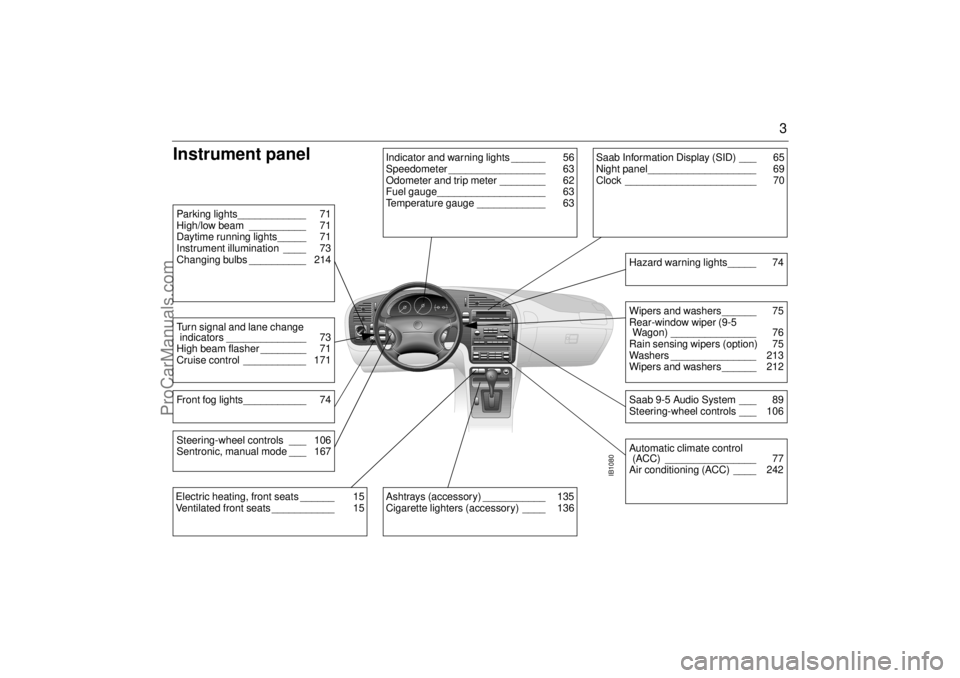
3
Instrument panel
IB1080
Indicator and warning lights ______ 56
Speedometer _________________ 63
Odometer and trip meter ________ 62
Fuel gauge___________________ 63
Temperature gauge ____________ 63
Parking lights____________ 71
High/low beam __________ 71
Daytime running lights_____ 71
Instrument illumination ____ 73
Changing bulbs __________ 214Turn signal and lane change
indicators ______________ 73
High beam flasher ________ 71
Cruise control ___________ 171Front fog lights___________ 74
Ashtrays (accessory) ___________ 135
Cigarette lighters (accessory) ____ 136
Saab Information Display (SID) ___ 65
Night panel___________________ 69
Clock _______________________ 70
Wipers and washers ______ 75
Rear-window wiper (9-5
Wagon) _______________ 76
Rain sensing wipers (option) 75
Washers _______________ 213
Wipers and washers ______ 212Saab 9-5 Audio System ___ 89
Steering-wheel controls ___ 106Hazard warning lights_____ 74Automatic climate control
(ACC) ________________ 77
Air conditioning (ACC) ____ 242
Electric heating, front seats ______ 15
Ventilated front seats ___________ 15Steering-wheel controls ___ 106
Sentronic, manual mode ___ 167
ProCarManuals.com
Page 5 of 288
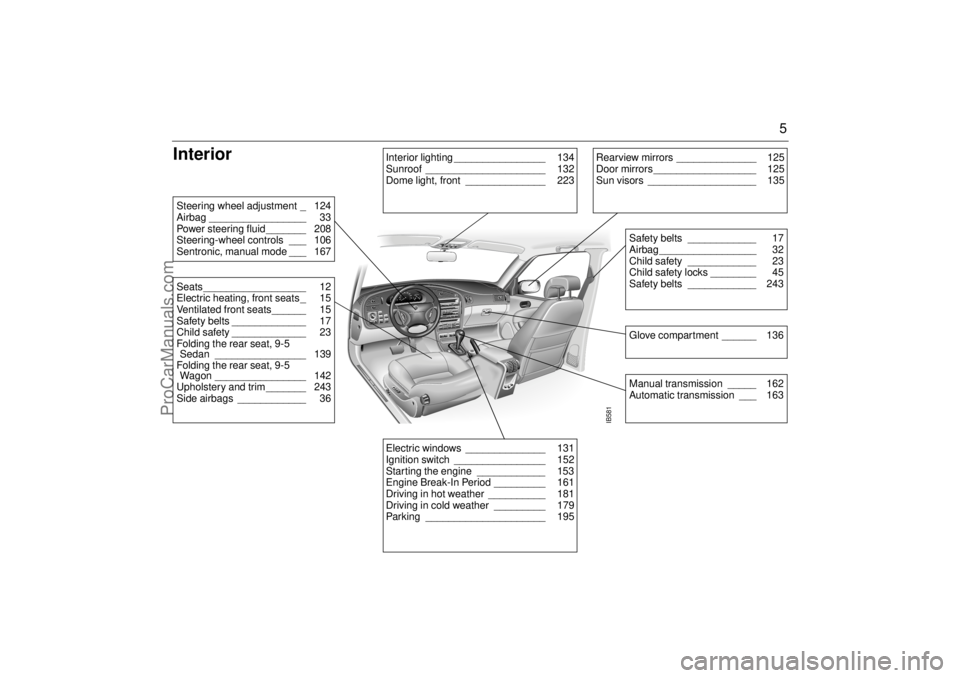
5
Interior
IB581
Rearview mirrors ______________ 125
Door mirrors __________________ 125
Sun visors ___________________ 135
Safety belts ____________ 17
Airbag _________________ 32
Child safety ____________ 23
Child safety locks ________ 45
Safety belts ____________ 243Glove compartment ______ 136Manual transmission _____ 162
Automatic transmission ___ 163
Electric windows ______________ 131
Ignition switch ________________ 152
Starting the engine ____________ 153
Engine Break-In Period _________ 161
Driving in hot weather __________ 181
Driving in cold weather _________ 179
Parking _____________________ 195
Steering wheel adjustment _ 124
Airbag _________________ 33
Power steering fluid _______ 208
Steering-wheel controls ___ 106
Sentronic, manual mode ___ 167Seats __________________ 12
Electric heating, front seats _ 15
Ventilated front seats______ 15
Safety belts _____________ 17
Child safety _____________ 23
Folding the rear seat, 9-5
Sedan ________________ 139
Folding the rear seat, 9-5
Wagon ________________ 142
Upholstery and trim _______ 243
Side airbags ____________ 36
Interior lighting ________________ 134
Sunroof _____________________ 132
Dome light, front ______________ 223
ProCarManuals.com
Page 10 of 288

10
No sparks,
flames or
smoking.Buckle up
Use protective
gogglesAirbag
Keep out of
reach of
children.Electric
windows
Battery acid
contains
sulphuric acid.Central
locking
Refer to the
Owner’s
Manual.Never place a
rear-facing
child seat in
this seat.
Risk of
explosive gas.
HeadlightsWindshield
wipers
Direction
indicatorsWindshield
washers
Parking lights Defroster
Hazard
warning lightsRear window
heating
Front fog
lightsVentilation fan
Rear fog lights
Coolant
temperatureRadiator fan
Battery
chargingFuel
Foot brake
Coolant level
Engine oil
pressure
ABS brakes
Examples of symbols that can be found in your car
ProCarManuals.com
Page 15 of 288
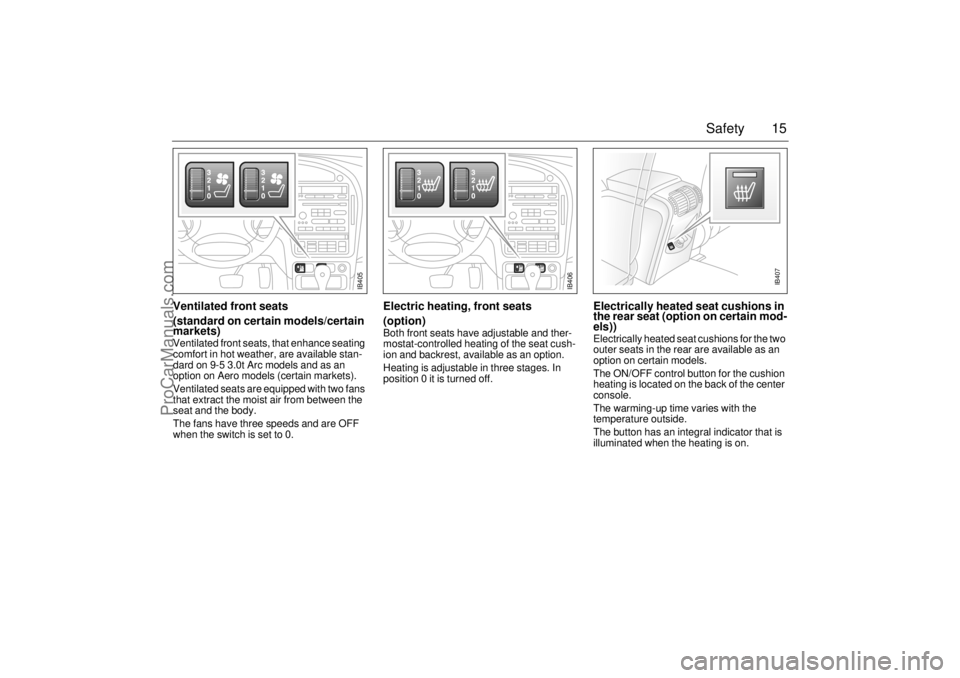
15 Safety
Ventilated front seats
(standard on certain models/certain
markets) Ventilated front seats, that enhance seating
comfort in hot weather, are available stan-
dard on 9-5 3.0t Arc models and as an
option on Aero models (certain markets).
Ventilated seats are equipped with two fans
that extract the moist air from between the
seat and the body.
The fans have three speeds and are OFF
when the switch is set to 0.
Electric heating, front seats
(option)Both front seats have adjustable and ther-
mostat-controlled heating of the seat cush-
ion and backrest, available as an option.
Heating is adjustable in three stages. In
position 0 it is turned off.
Electrically heated seat cushions in
the rear seat (option on certain mod-
els))Electrically heated seat cushions for the two
outer seats in the rear are available as an
option on certain models.
The ON/OFF control button for the cushion
heating is located on the back of the center
console.
The warming-up time varies with the
temperature outside.
The button has an integral indicator that is
illuminated when the heating is on.
IB405
IB406
IB407
ProCarManuals.com
Page 59 of 288
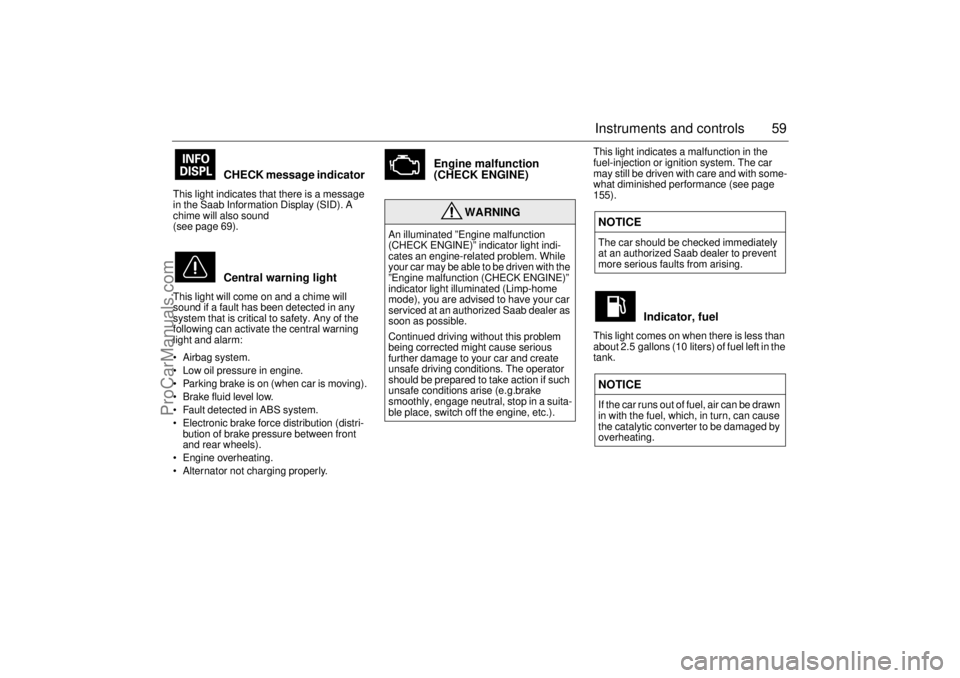
59 Instruments and controls
CHECK message indicator
This light indicates that there is a message
in the Saab Information Display (SID). A
chime will also sound
(see page 69).
Central warning light
This light will come on and a chime will
sound if a fault has been detected in any
system that is critical to safety. Any of the
following can activate the central warning
light and alarm:
Airbag system.
Low oil pressure in engine.
Parking brake is on (when car is moving).
Brake fluid level low.
Fault detected in ABS system.
Electronic brake force distribution (distri-
bution of brake pressure between front
and rear wheels).
Engine overheating.
Alternator not charging properly.
Engine malfunction
(CHECK ENGINE)
This light indicates a malfunction in the
fuel-injection or ignition system. The car
may still be driven with care and with some-
what diminished performance (see page
155).
Indicator, fuel
This light comes on when there is less than
about 2.5 gallons (10 liters) of fuel left in the
tank.
WARNING
An illuminated ”Engine malfunction
(CHECK ENGINE)” indicator light indi-
cates an engine-related problem. While
your car may be able to be driven with the
”Engine malfunction (CHECK ENGINE)”
indicator light illuminated (Limp-home
mode), you are advised to have your car
serviced at an authorized Saab dealer as
soon as possible.
Continued driving without this problem
being corrected might cause serious
further damage to your car and create
unsafe driving conditions. The operator
should be prepared to take action if such
unsafe conditions arise (e.g.brake
smoothly, engage neutral, stop in a suita-
ble place, switch off the engine, etc.).
NOTICEThe car should be checked immediately
at an authorized Saab dealer to prevent
more serious faults from arising.NOTICEIf the car runs out of fuel, air can be drawn
in with the fuel, which, in turn, can cause
the catalytic converter to be damaged by
overheating.
ProCarManuals.com
Page 69 of 288

69 Instruments and controls
CHECK messages When the engine is started, CHECKING will
appear on the display for about four sec-
onds, while the SID checks are being per-
formed.
When a CHECK message is generated
while the car is being driven, a chime will
sound, INFO DISPL will illuminate on the
main instrument panel, and the message
will appear on the SID. The number of mes-
sages that can be displayed by the SID
varies with the specification of the car.
If more than one CHECK message has
been generated, the
+ symbol will appear to
the left of the text on the display. The mes-
sages appear in order of priority.
If a new fault occurs while another message
is being displayed, the message relating to
the new one will appear for 10 seconds,
after which the display will return to the ear-
lier one.
Press CLEAR once to acknowledge a mes-
sage, whereupon it will be cleared from the
display. It will not be displayed again before
the ignition has been switched off and then
on again. The following messages may be displayed:
1 This message will be displayed approxi-
mately 600 miles (1,000 km) before the next
scheduled service is due, or when 365 days
have elapsed since the last service. The
message should be cleared at the time of that
service (see the Saab Warranties & Service
Record Booklet).
This message can also be deleted by first
briefly pressing the CLEAR button, then
depressing it a second time for at least eight
seconds until ”SERVICE” appears on the dis-
play and a chime sounds. The message can
only be deleted when it is shown on the SID.
Night panelTo improve night-driving conditions inside
the car, the Night Panel mode can be
selected. In this mode, the amount of infor-
mation displayed is reduced, and only the
most important instruments and displays
will be illuminated.
When the Night Panel button is pressed,
only the speedometer will be illuminated (up
to the 87-mph or 140-km/h graduation), all
the other instruments illumination being
extinguished and their needles moved to
zero. Both the SID and the ACC displays will
be extinguished and the backlighting for
switches and other controls will be dimmed.
Note: All indicator and warning lights,
together with the display of CHECK mes-
sages, will operate as normal, except ”Out-
door temperature (Frost warning)”, see
page 66. Message See
page
FRONT LIGHT FAILURE 215
REAR LIGHT FAILURE 219
FOG LIGHT FAILURE 219
BRAKE LIGHT FAILURE 219
WASHER FLUID LEVEL LOW 213
FILL COOLANT FLUID 206
REPLACE KEY BATTERY 45
KEY NOT ACCEPTED 52
SERVICE THEFT ALARM 52
TRANSMISSION OVERHEATING 166
TIGHTEN FUEL FILLER CAP 158
TIME FOR SERVICE
1)
254
ProCarManuals.com
Page 77 of 288

77 Instruments and controls
Automatic climate
control (ACC) The ACC system automatically works to
maintain the desired temperature inside the
car.
The system will achieve the desired temper-
ature in the quickest possible way. Note that
selecting a higher or lower temperature than
that desired will not speed up the process.
For the ACC system to be most effective, all
windows (and sunroof, if fitted) should be
closed.
Fresh air for the cabin is drawn in through an
inlet grille adjacent to the bottom edge of the
windshield. The air flows through a filter
upstream of the ACC system before deliv-
ery to the cabin. Cabin air is evacuated via
openings in the rear parcel shelf and then
through outlets on either side of the car
behind the rear bumper.
The incoming air is treated in three stages:
first it passes through a filter; it is then dehu-
midified and cooled and, finally, if required,
heated.
The filter is a combined particle and char-
coal filter. It is so efficient that levels of nox-
ious substances such as benzene and tolu-
ene are also reduced.To reduce the likelihood of misting on the
insides of the windows, the glass should be
cleaned with a quality window cleaner. How
often this will need to be done depends on
how clean the air is – if there are smokers in
the car, cleaning will need to be done more
frequently.
AUTO
ECON OFF
AUTO
ÂşF
ÂşC
ÂşF
ÂşC
ECON OFF
IB367
9
1
5
4
23
68
7
ACC panel 1 Temperature setting: LH side
2 AUTO: All settings selected automatically
3 Manual setting of fan speed
4 Manual setting of air distribution
5 Rear-window heating: ON/OFF 6 Recirculation: ON/OFF
7 A/C compressor: ON/OFF
8 ACC system: ON/OFF
9 Temperature setting: RH side
ProCarManuals.com
Page 81 of 288
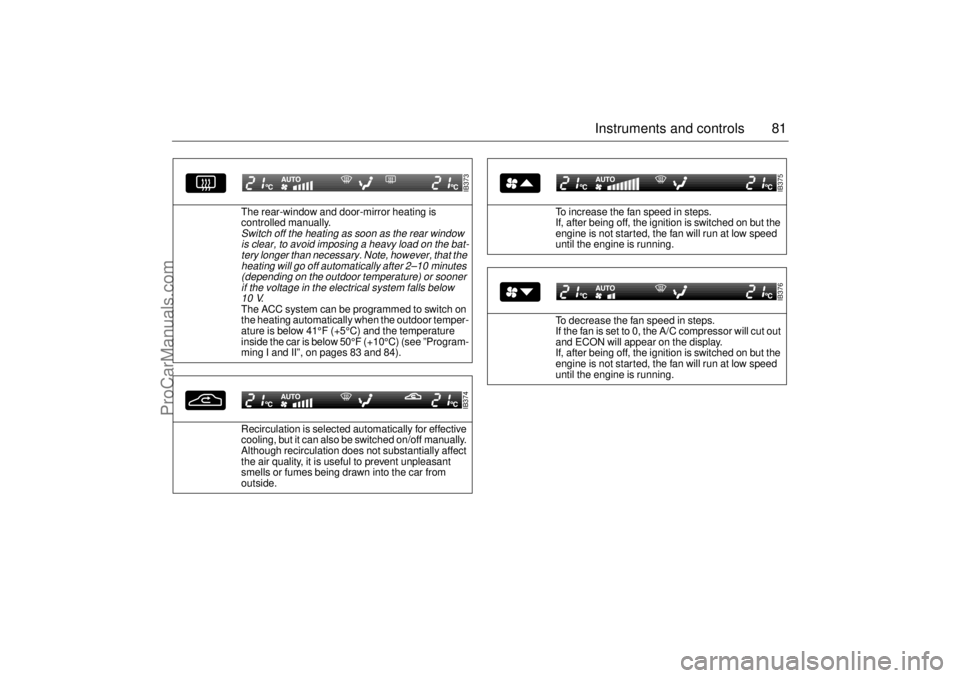
81 Instruments and controls
The rear-window and door-mirror heating is
controlled manually. Switch off the heating as soon as the rear window
is clear, to avoid imposing a heavy load on the bat-
tery longer than necessary. Note, however, that the
heating will go off automatically after 2–10 minutes
(depending on the outdoor temperature) or sooner
if the voltage in the electrical system falls below
10 V
.
The ACC system can be programmed to switch on
the heating automatically when the outdoor temper-
ature is below 41°F (+5°C) and the temperature
inside the car is below 50°F (+10°C) (see ”Program-
ming I and II”, on pages 83 and 84).
Recirculation is selected automatically for effective
cooling, but it can also be switched on/off manually.
Although recirculation does not substantially affect
the air quality, it is useful to prevent unpleasant
smells or fumes being drawn into the car from
outside.
IB373IB374
To increase the fan speed in steps.
If, after being off, the ignition is switched on but the
engine is not started, the fan will run at low speed
until the engine is running.
To decrease the fan speed in steps.
If the fan is set to 0, the A/C compressor will cut out
and ECON will appear on the display.
If, after being off, the ignition is switched on but the
engine is not started, the fan will run at low speed
until the engine is running.
IB375IB376
ProCarManuals.com
Page 82 of 288
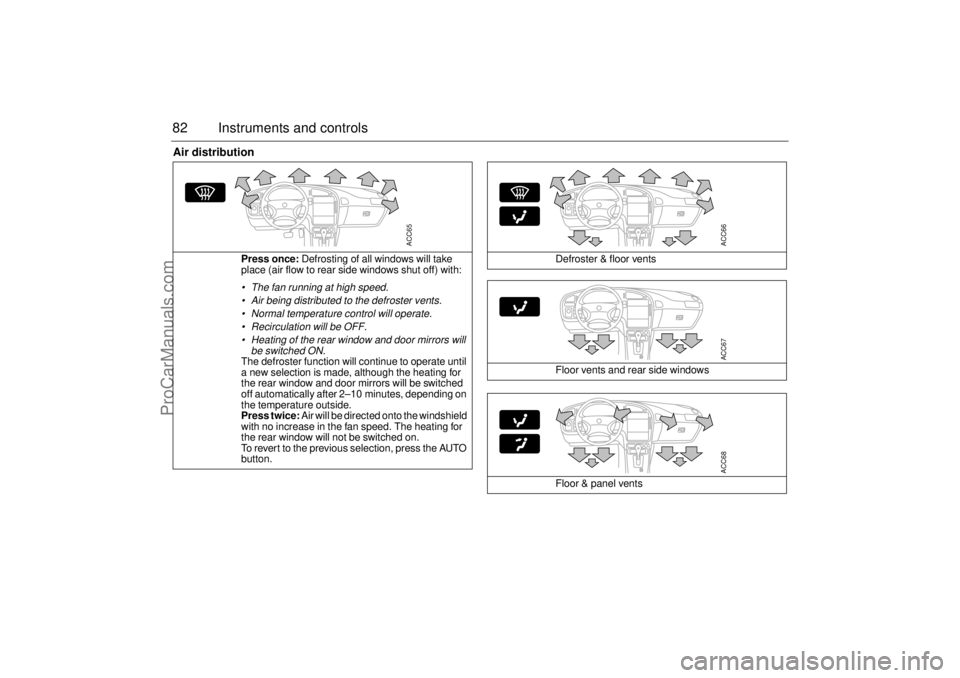
82 Instruments and controlsAir distribution
Press once: Defrosting of all windows will take
place (air flow to rear side windows shut off) with: The fan running at high speed.
Air being distributed to the defroster vents.
Normal temperature control will operate.
Recirculation will be OFF.
Heating of the rear window and door mirrors will
be switched ON.The defroster function will continue to operate until
a new selection is made, although the heating for
the rear window and door mirrors will be switched
off automatically after 2–10 minutes, depending on
the temperature outside.
Press twice: Air will be directed onto the windshield
with no increase in the fan speed. The heating for
the rear window will not be switched on.
To revert to the previous selection, press the AUTO
button.
ACC65
Defroster & floor vents
Floor vents and rear side windows
Floor & panel vents
ACC66ACC67ACC68
ProCarManuals.com
Page 84 of 288
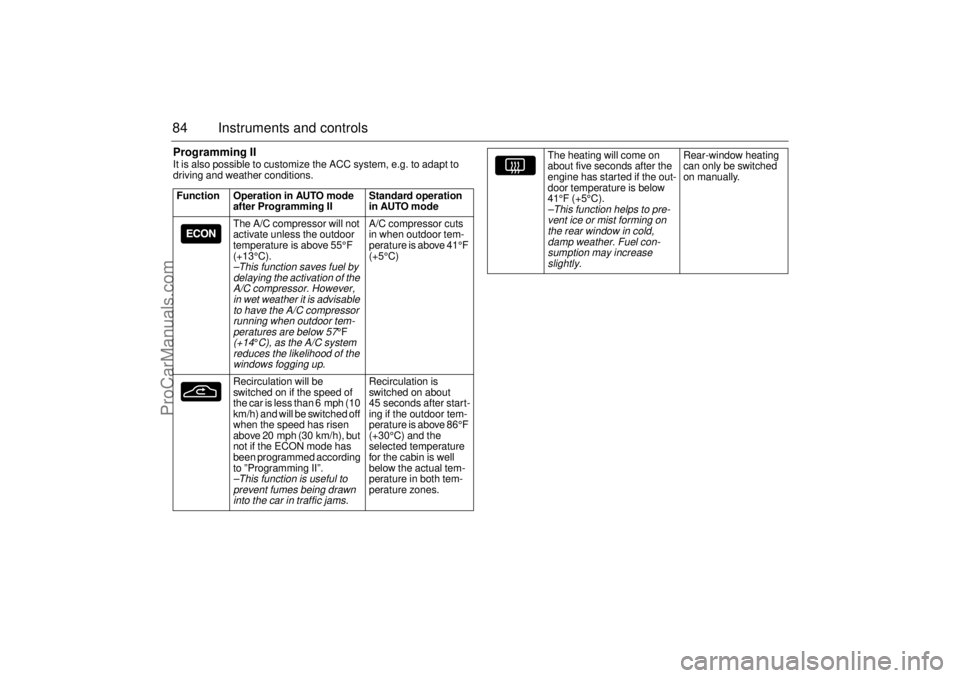
84 Instruments and controlsProgramming IIIt is also possible to customize the ACC system, e.g. to adapt to
driving and weather conditions.
Function Operation in AUTO mode
after Programming II Standard operation
in AUTO mode
The A/C compressor will not
activate unless the outdoor
temperature is above 55°F
(+13°C).
–This function saves fuel by
delaying the activation of the
A/C compressor. However,
in wet weather it is advisable
to have the A/C compressor
running when outdoor tem-
peratures are below
57°F
(+14
°C), as the A/C system
reduces the likelihood of the
windows fogging up.
A/C compressor cuts
in when outdoor tem-
perature is above 41°F
(+5°C)
Recirculation will be
switched on if the speed of
the car is less than 6 mph (10
km/h) and will be switched off
when the speed has risen
above 20 mph (30 km/h), but
not if the ECON mode has
been programmed according
to ”Programming II”.
–This function is useful to
prevent fumes being drawn
into the car in traffic jams.
Recirculation is
switched on about
45 seconds after start-
ing if the outdoor tem-
perature is above 86°F
(+30°C) and the
selected temperature
for the cabin is well
below the actual tem-
perature in both tem-
perature zones.
The heating will come on
about five seconds after the
engine has started if the out-
door temperature is below
41°F (+5°C).–This function helps to pre-
vent ice or mist forming on
the rear window in cold,
damp weather. Fuel con-
sumption may increase
slightly.
Rear-window heating
can only be switched
on manually.
ProCarManuals.com